Key Points:
COVID
- In today’s Recommendation for Industry, we discuss the expected fall increase in respiratory illnesses. Read more below.
- COVID vaccines in pregnancy tied to lower risk of NICU stay, stillbirth. Japanese researchers led the analysis of nine observational studies comparing the pregnancy outcomes of 81,349 women who received at least one COVID-19 vaccine dose with those of 255,346 unvaccinated peers through Apr 5, 2022. COVID-19 vaccination during pregnancy was tied to lower risk of NICU admission (odds ratio [OR], 0.88), stillbirth (OR, 0.73), and maternal SARS-CoV-2 infection (OR, 0.46) and no significant additional risk of preterm birth (OR, 0.89), SGA (OR, 0.99), low Apgar score (indicator of newborn needing medical attention; OR, 0.94), cesarean delivery (OR, 1.05), postpartum hemorrhage (OR, 0.95), or chorioamnionitis (infection of the placenta or amniotic fluid; OR, 0.95).
- Omicron BA.4.6 makes up nearly 13% of COVID variants circulating in U.S. The U.S. Centers for Disease Control and Prevention (CDC) on Tuesday estimated that nearly 13% of the circulating coronavirus variants in the United States were of the BA.4.6 subvariant of Omicron, as of the week ended Oct. 1. Omicron subvariants BA.5 and BA.4 were estimated to make up 81.3% and 1.1%, respectively.
- U.S. CDC ends country-specific COVID travel health notices. CDC said on Monday it will only post a travel health notice “for a country if a situation, such as a concerning COVID-19 variant, is identified that changes CDC travel recommendations for that country.”
Food Safety & Public Health
- Ebola kills another health worker in Uganda outbreak. The health worker is a 58-year-old woman who worked as an anesthetic officer. She died at Fort Portal Hospital after a 17-day battle with the disease. At a World Health Organization (WHO) briefing, Director-General Tedros Adhanom Ghebreyesus, PhD, said so far, 63 confirmed and probable cases have been reported, including 29 deaths.
- Treating and Preventing Head Lice. Back-to-school time in the fall usually peaks with cases of lice. The FDA provides a whole list of ways to prevent getting head lice but note that avoiding direct contact with someone who has head lice is the best preventive measure. Read more ways to prevent head lice here. If your child has head lice, talk with your child’s health care professional or pharmacist about the recommended treatment for your child.
- FDA reveals cantaloupe was behind outbreak of Salmonella Typhimurium infections. First posted on Aug. 17 by the Food and Drug Administration, there has been little information available on the outbreak, except for the patient count, which currently stands at 87. The agency did not report whether the cantaloupe involved was whole fruit or fresh cut. It also did not reveal a grower, packer, distributor, or retailers where the cantaloupe was produced and sold.
- New Zealand links hepatitis A berry cases to EU illnesses. There are 12 hepatitis A infections from eating frozen berries in New Zealand. Eight have been linked by genetic sequencing, meaning they were likely exposed to the same source of the virus. Foodstuffs Own Brands has recalled various Pams brand frozen berry products because of a possible link to the hepatitis A cases. There is some suspicion around a correlation to berries from Serbia currently.
- How to report seafood-related toxin and Scombrotoxin fish poisoning illnesses. A web page provides information on commonly occurring seafood-related illnesses and how to report them to the Food and Drug Administration. To report an illness from raw bivalve molluscan shellfish, email the FDA at shellfishepi@fda.hhs.gov. The most commonly occurring illnesses are Ciguatera Fish Poisoning (CFP), Puffer Fish Poisoning (PFP), Scombrotoxin Fish Poisoning (SFP), and Seafood-associated Rhabdomyolysis (sometimes referred to as Haff disease).
- CDC says outbreak linked to Wendy’s sandwiches is over with more than 100 sick. The Centers for Disease Control and Prevention (CDC) is reporting that the total number of confirmed patients is 109. As of the report tonight from the CDC the specific source of the E. coli could not be 100 percent confirmed. However, 83 percent of 82 patients for whom the information was available reported eating at Wendy’s before becoming ill.
Recommendations for Industry
Expected Fall Increase in Respiratory Illness Has Begun
The ups and downs of infectious diseases are especially evident in this week’s Communicable Disease Update. While monkeypox is showing a significant reduction both in the U.S. and globally with no indication or rationale for it to change direction and resurge, respiratory illnesses (including flu and COVID) are taking a typically autumn turn upward.
The primary areas that we’re seeing influenza take hold are Texas and Washington D.C. which are both at “red,” very high levels. Additionally, the south and southeast areas of the U.S. are beginning to move into low and moderate levels. While we would normally have expected levels to rise faster in the north, with people moving indoors as the weather cools, it is not uncommon at all for levels of the flu and other respiratory diseases to increase in the fall.
We are currently seeing very, very low levels with only two states (Kentucky and Rhode Island) with case rates above 25/100K people – the first time we’ve seen levels that low since we began tracking! But, as we noted above, with respiratory illnesses typically increasing this time of year, we would expect to see a slight surge in COVID cases as well.
What all of this tells us is that businesses need to continue monitoring wellness, encouraging vaccinations, and ensuring that workers who are ill stay at home. This is particularly true this year as the flu levels are quite a bit higher than they were this time last year – which could likely be attributed to the continual relaxation of respiratory protections as COVID has waned.
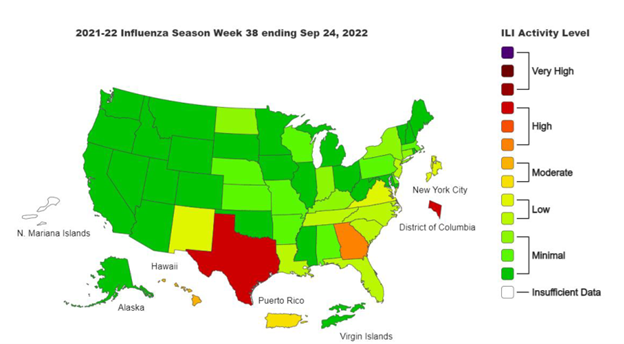
COVID Risk Matrix:
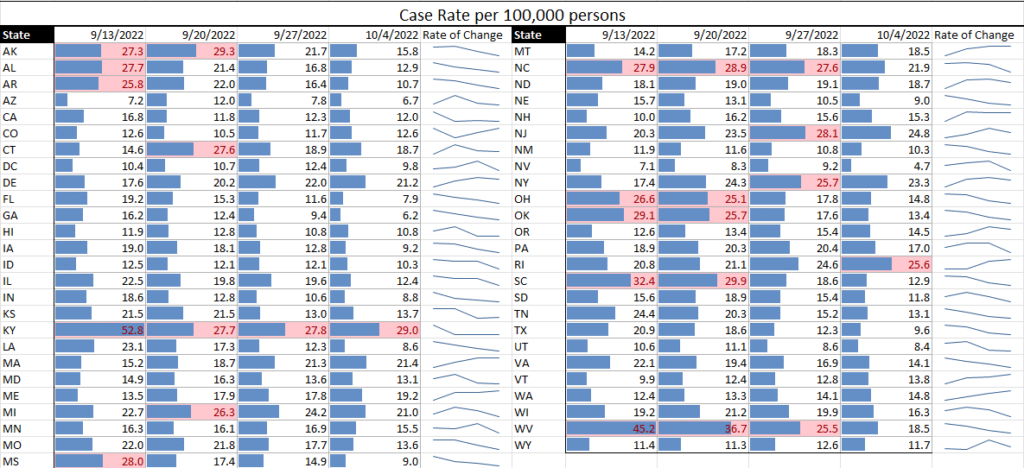

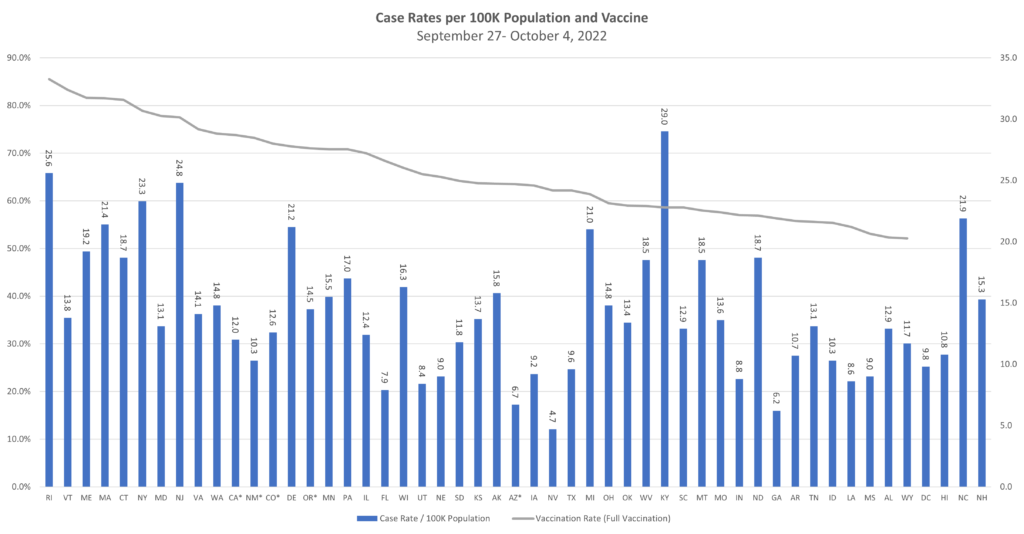
Monkeypox:
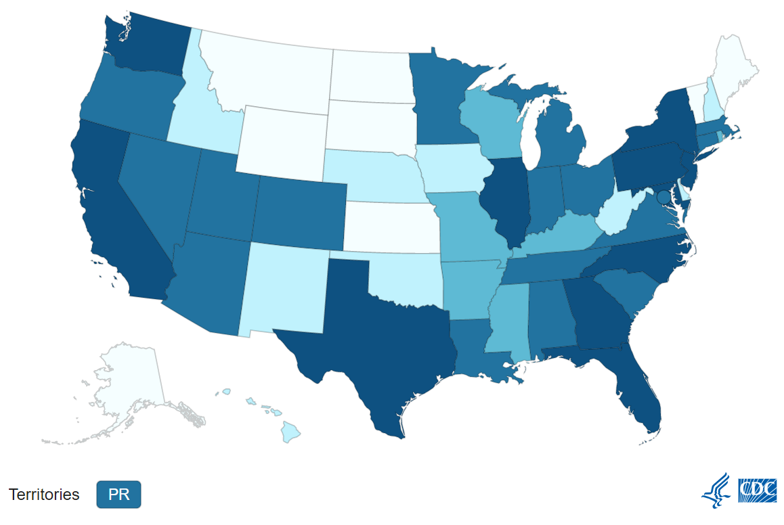

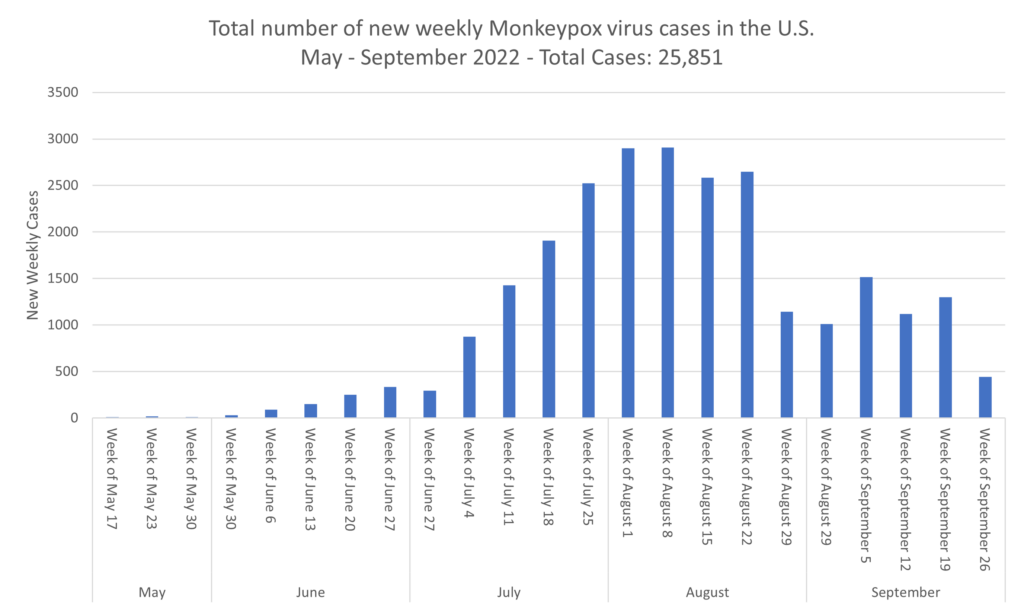
In case you missed it:
COVID
- In Tuesday’s Recommendation for Industry, we discussed the current Hepatitis A spread in Europe. Read more here.
- Universal masking no longer recommended in health care facilities, CDC says. The CDC no longer recommends universal masking in health care settings unless the facilities are in areas of high COVID-19 transmission. Per the new recommendations, facilities in areas without high transmission can “choose not to require” all doctors, patients and visitors to wear masks. Regardless of the new guidance, the CDC still recommends masking in health care settings for people who have suspected or confirmed COVID-19 or other respiratory infections, people who have had close contact or a higher risk exposure with someone with COVID-19 and people who reside or work on a unit or area of the facility experiencing an outbreak, regardless of universal requirements and transmission rates.
- COVID-19 continues upward trend in Europe. Europe’s COVID cases showed more signs of rising last week, marking the first regionwide spike since the most recent BA.5 wave. Cases in people ages 65 and older rose 9% compared to the previous week, which the ECDC said was led by recent increases in 14 of 26 countries in the European Union that reported data. In a weekly update, the Centers for Disease Control and Prevention (CDC) said the 7-day average for new daily cases decreased 13.1% compared to the week before, with the 7-day average for new COVID deaths down 6.7%. In other updates, the CDC said more than 7.5 million people have gotten their updated booster doses, up from 4.4 million last week. However, it also noted that 49.9% of the eligible population has yet to receive any booster dose.
Monkeypox
- First monkeypox case in UK likely seen in March. The World Health Organization (WHO) and the European Centre for Disease Prevention and Control (ECDC) released a new report on the monkeypox outbreak in Europe and noted that the first specimen identified through retrospective testing in the United Kingdom was on Mar 7, and the earliest date of symptom onset was reported on Apr 17.
Food Safety & Public Health
- As of September 29th, 50 suspected cases of Ebola have been reported in Uganda including 31 confirmed and 19 probable cases. 24 deaths have been reported. Cumulatively, 414 contacts have been reported. Discussions continue about the possible benefits of a vaccine trial against the causative strain. It does not appear that cases have spread outside of Uganda so far, and other African countries have implemented health screenings at border crossings. Over the past 4 days, Uganda’s health ministry has reported 8 more Ebola Sudan cases, along with 2 more deaths, with officials also announcing that a doctor is among the fatal cases.
- Measles: Since the start of an outbreak this past April, 698 children have died from measles in Zimbabwe, according to the country’s health ministry, and there has been a total of 6,291 cases recorded as of 4 September 2022. The deaths have been attributed to unvaccinated children who did not receive a vaccine because of religious beliefs. While the outbreak was originally reported in the Manicaland province, in the eastern part of Zimbabwe, measles cases have since been reported in all regions of the country.
- The Minnesota Department of Health (MDH) said Monday that the state has a measles outbreak. The department said it has identified 12 cases of international travel-related measles in unvaccinated children since June. As a result, vaccinations are encouraged.
- Rise in Hepatitis A cases in EU and UK could partly be foodborne. Data suggests human-to-human transmission and contaminated food are the sources of an increase of Hepatitis A infections throughout EU and UK. More than 300 cases with identical or closely related HAV strains have been identified in Austria, Germany, Hungary, the Netherlands, Slovenia, Sweden, and the UK. Good hand hygiene, including thoroughly washing hands with soap after using the bathroom and before preparing or eating food, plays an important role in preventing the spread of hepatitis A.
- FDA links Listeria outbreak to cheeses sold at Whole Foods, Safeway and other retailers. The FDA is investigating an outbreak of infections caused by Listeria monocytogenes that are linked to certain Brie and Camembert cheeses that were sold nationwide. Old Europe Cheese, Inc. of Benton Harbor, MI, recalled multiple cheese products in relation to the outbreak. A list of those products along with retailers who sold the cheeses is at this link. The firm has stopped production and distribution of their Brie and Camembert products from the Michigan facility and is working with FDA on corrective actions. Consumers, restaurants, and retailers should not eat, sell, or serve recalled products and should throw them away; this includes Best By Dates ranging from September 28, 2022, to December 14, 2022, and all flavors and quantities.
- FDA Reminds Human and Animal Food Facilities to Register or Renew Registration between October 1 and December 31, 2022. Owners, operators, or agents in charge of a domestic or foreign facility engaged in manufacturing/processing, packing, or holding food for consumption by humans or animals in the U.S., are required to register the facility with the FDA. The registration and renewal period is open between October 1 and December 31, 2022. The FDA will consider the registration of a food facility to be expired if a facility’s registration is not renewed by December 31, 2022. There is no fee associated with registration or renewal.





